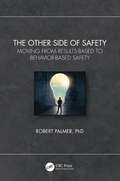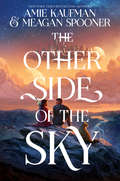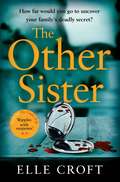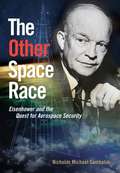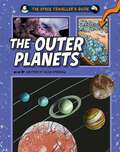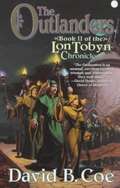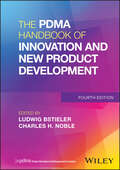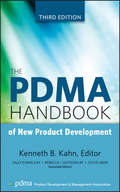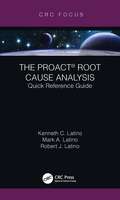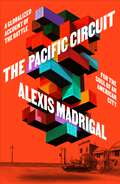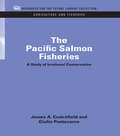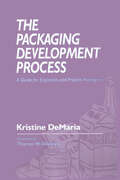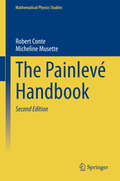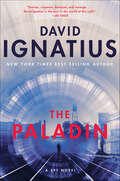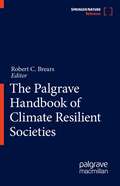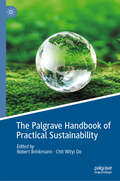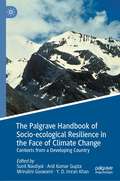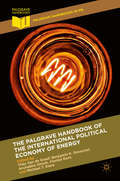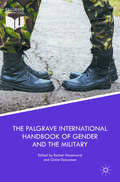- Table View
- List View
The Other Side of Safety: Moving from Results-Based to Behavior-Based Safety
by Robert PalmerThe problem with the way the safety industry functions is three-fold: (1) the dysfunctional relationship between business and safety leaders, (2) the practice of Results-Based Safety, and (3) the creation of a false reality. This book presents an insightful and practical approach to how you can move your safety program from Results-Based to Behavior-Based Safety. The move involves understanding what motivates behavior, utilization of consequences, practicing the seven steps of performance coaching, creating accurate safety campaigns, and defining evidence of a healthy Behavior-Based Safety program—this is the other side of safety.. The text: Defines the four major motivations, explains how they work, and how safety leaders can use the right motivation for the right person to help them practice safe behavior Explains how to maximize the impact of reinforcement consequences and minimize punitive consequences in a way that is alingned with an individual’s motivation Implements the seven steps of performance coaching conversations, how safety and business leaders can model fluency and frequency to shape behavior to habit strength Provides clearly defined evidence of a healthy Behavior-Based safety program by measuring outcome like locus of control, self-esteem, self-efficacy, and self-actualization Highlights the distinction between Results-Based Safety (RBS) anecdotal practices from the science of Behavior-Based Safety (BBS) methodology Showcases how the distinct difference between a mechanistic and organic culture, and how the four phenomena can be utilized to drive safety culture on purpose Discusses the importance of expanding from lagging indicators to leading indicators for robust metrics and predictability Addresses how the significant negative impact of "telling people what to do" and re-focuses on coaching people on "what to think" The book provides definitions, examples, and applications that focus on how safety and business leaders can influence the behavior of people, impact their culture, and support healthy relationships. It will serve as an ideal text for students, professionals, and researchers in the fields of ergonomics, human factors, human-computer interaction, industrial-organizational psychology, and computer engineering.
The Other Side of the Sky
by Amie Kaufman Meagan SpoonerNew York Times bestselling author duo Amie Kaufman and Meagan Spooner have crafted a gripping tale of magic and logic, fate and choice, and a deadly love. Perfect for fans of Laini Taylor and Brandon Sanderson. Prince North’s home is in the sky, in a gleaming city held aloft by intricate engines, powered by technology. Nimh is the living goddess of her people on the Surface, responsible for providing answers, direction—hope. North’s and Nimh’s lives are entwined—though their hearts can never be. Linked by a terrifying prophecy and caught between duty and fate, they must choose between saving their people or succumbing to the bond that is forbidden between them.
The Other Sister: A gripping, twisty novel of psychological suspense with a killer ending that you wont see coming
by Elle CroftFirst there was The Guilty Wife. Now read Elle Croft's next twisty psychological suspense novel, The Other Sister.**************************How far would you go...Gina Mills is desperate to be a newsreader, but her boss - the director of the struggling Channel Eight, won't help.Walking home one night, Gina stumbles upon a dead body, and after calling the police, she makes the split-second decision to report the murder live. When questioned by the police, Gina can't remember specific details about her discovery, but these memory gaps are explained away as shock. ...to uncover your family's deadly secret?But when Gina finds a second body, it's clear she's being targeted. But why? And how is this connected to the death of Gina's younger sister so many years ago?Fans of Friend Request by Laura Marshall, Sweet Little Lies by Caz Frear, The Mistake by KL Slater, The Secret Mother by Shalini Boland and The Angel by Katerina Diamond will love The Other Sister.************************** Praise for Elle Croft's first novel, the intensely gripping The Guilty Wife 'Full of twists and turns, THE GUILTY WIFE is a gripping tale of betrayal, deceit, and duplicity. The ending will stay with you long after you've finished the last page. Fabulous.' Jenny Blackhurst, bestselling author of How I Lost You and Before I Let You In'I couldn't put this down. Pacy and gripping.' Cass Green, author of the number 1 ebook bestseller The Woman Next Door'An accomplished debut with a relentless and intense pace that kept me completely rapt and eager to find out answers. I loved the final twist.' KL Slater, international bestselling author of Safe With Me, Blink and Liar.'A gripping psychological thriller. This debut is skilfully plotted and I had to keep turning the pages as the tension increased - I just couldn't put it down. And the ending! You just have to read it. I am looking forward to more from Elle Croft.' Patricia Gibney, bestselling author of The Missing Ones'A gripping portrayal of a woman under fire, which explores the blurry boundaries of innocence and guilt. The Guilty Wife will make you question those closest to you as the plot unfolds at pace, with an ending that pulls the rug from under your feet. A brilliant debut.' Phoebe Morgan, author of The Doll House'Twisty and fast-moving, The Guilty Wife kept me guessing until the very end! A great read.' Isabel Ashdown, author of Little Sister and Beautiful Liars'What a clever idea! This kept me reading through the night to see how 'the guilty wife' would get out of this one...' Jane Corry, author of My Husband's Wife and Blood Sisters.'I read The Guilty Wife in an intense two day sitting. Brilliant.' Niki Mackay, author of I,Witness.
The Other Sister: A gripping, twisty novel of psychological suspense with a killer ending that you won’t see coming
by Elle Croft'WOW, just WOW, The Other Sister is a mesmerising, mind blowing psychological thriller that has so many twists and turns.' Amazon Reviewer, 5 stars'It's a great plot line and you are sucked in from the first page. It's a fast paced psychological thriller with plenty of twists and turns.' Amazon Reviewer, 5 stars**************************What would you do for a moment in the spotlight?Gina Mills is desperate to be a newsreader, but her boss just won't help.Walking home one night, Gina stumbles upon a dead body, and after calling the police, she makes the split-second decision to report the murder live.When questioned by the police, Gina can't remember specific details about her discovery, but these memory gaps are explained away as shock.But when Gina finds a second body, it's clear she's being targeted. But why?And exactly how far will she go to keep her 15 minutes of fame?Fans of The Hermitage by LJ Ross, The Girl in the Letter by Emily Gunnis, The Birthday by Carol Wyer, The Stolen Boys by Joy Ellis and Silent Victim by Caroline Mitchell will love The Other Sister.************************** Praise for Elle Croft's first novel, the intensely gripping The Guilty Wife 'Full of twists and turns, THE GUILTY WIFE is a gripping tale of betrayal, deceit, and duplicity. The ending will stay with you long after you've finished the last page. Fabulous.' Jenny Blackhurst, bestselling author of How I Lost You and Before I Let You In'I couldn't put this down. Pacy and gripping.' Cass Green, author of the number 1 ebook bestseller The Woman Next Door'An accomplished debut with a relentless and intense pace that kept me completely rapt and eager to find out answers. I loved the final twist.' KL Slater, international bestselling author of Safe With Me, Blink and Liar.'A gripping psychological thriller. This debut is skilfully plotted and I had to keep turning the pages as the tension increased - I just couldn't put it down. And the ending! You just have to read it. I am looking forward to more from Elle Croft.' Patricia Gibney, bestselling author of The Missing Ones'A gripping portrayal of a woman under fire, which explores the blurry boundaries of innocence and guilt. The Guilty Wife will make you question those closest to you as the plot unfolds at pace, with an ending that pulls the rug from under your feet. A brilliant debut.' Phoebe Morgan, author of The Doll House'Twisty and fast-moving, The Guilty Wife kept me guessing until the very end! A great read.' Isabel Ashdown, author of Little Sister and Beautiful Liars'What a clever idea! This kept me reading through the night to see how 'the guilty wife' would get out of this one...' Jane Corry, author of My Husband's Wife and Blood Sisters.'I read The Guilty Wife in an intense two day sitting. Brilliant.' Niki Mackay, author of I,Witness.
The Other Space Race: Eisenhower And The Quest For Aerospace Security
by Nicholas Michael SambalukThe Other Space Race is a unique look at the early U. S. space program and how it both shaped and was shaped by politics during the Cold War. Eisenhower’s "New Look” expanded the role of the Air Force in national security, and ultimately allowed ambitious aerospace projects, namely the "Dyna-Soar,” a bomber equipped with nuclear weapons that would operate in space. Eisenhower’s space policy was purely practical, creating a strong deterrent against the use of nuclear arms against the United States. With the Soviet launch of Sputnik in 1957, the political climate changed, and space travel became part of the United States’ national discourse. Sambaluk explores what followed, including the scuttling of the "Dyna-Soar” program and the transition from Eisenhower’s space policy to John Kennedy’s. This well-argued, well-researched book gives much needed perspective on the Cold War’s influence on space travel and it’s relation to the formation of public policy.
The Outer Planets (The Space Traveller's Guide)
by Giles SparrowTop tips for space travellers! Get to know the outer planets of your solar system in this up-close tour of key cosmic destinations.The Space Traveller's Guide: The Outer Planets is a personal tour of the gassy and icy planets furthest from the Sun - Jupiter, Saturn, Uranus and Neptune - plus a pit-stop among the comets, several amazing moons and even a look beyond the planets to the Kuiper Belt, Oort Cloud and of course the dwarf planets! Learn the unmissable formations at each location, from Saturn's Dragon Storm to the snow-spewing geysers on the surface of the moon Enceladus. Includes 'Traveller's Tips' for surviving extreme conditions in each spot, and don't miss the real-life tour photos at the back!The Space Traveller's Guide series is the perfect one-stop-shop for space lovers, brought to you by expert astronomy and physics author Giles Sparrow. It includes astounding facts to inspire young space-travel hopefuls, plus humorous cartoons to draw them through the pages, and presents key science learning in an accessible format for readers aged 9 and up.Contents list, The Outer Planets: The outer solar system / Jupiter / Io / Europa / Ganymede and Callisto / Saturn / Ringed wonder / Saturn's moons / Uranus / Neptune / Comets / Beyond the planets / Tour snapshots / Glossary / Resources / IndexThe series includes: Earth and the Inner Planets, The Outer Planets, The Sun and Stars and Space Exploration
The Outlanders (The Lon Tobyn Chronicle, Book #2)
by David B. CoeIn this second book of the trilogy, Jaryd must venture into the land of his enemies. Followed by the Eagle-Sage.
The PDCA Cycle for Industrial Improvement: Applied Case Studies (Synthesis Lectures on Engineering, Science, and Technology)
by Jorge Luis García Alcaraz Arturo Realyvásquez Vargas Suchismita Satapathy José Roberto Díaz-RezaThis book provides a conceptual description of the PDCA cycle and the tools that support it. A brief literature review is given for each tool, indicating the timeline according to Scopus, the main areas in which they are applied, the main authors and the journals that most publish on these topics. It reports three industrial applications, one focusing on cost reduction, the second on optimizing a manufacturing company's raw material receiving process, and the third one on eliminating waste and increasing performance.
The PDMA Handbook of Innovation and New Product Development
by Charles H. Noble Ludwig BstielerTHE PDMA HANDBOOK OF INNOVATION AND NEW PRODUCT DEVELOPMENT State-of-the-art overview of all aspects of new product development from start to finish The Product Development and Management Association (PDMA) Handbook of Innovation and New Product Development provides an exceptional review of cutting-edge topics for both new and experienced product development leaders, and academics interested in emerging research, offering a comprehensive and updated guide to the practices, processes, and tools critical to achieving and sustaining new product/service development success in today’s world and delivering valuable information on the fundamentals as well as emerging practices. This edition is completely revised to include 32 new and refreshed chapters on topics including: Creating Successful Innovation, Sustainable New Product Development (NPD), Digital Transformation of NPD, the Changing Role of Design Thinking, Market Forecasting, and much more. In The Product Development and Management Association (PDMA) Handbook of Innovation and New Product Development, readers can expect to find specific information on: What separates the winners from the losers when it comes to new products, plus what drives new product success from a holistic standpoint Effective front end innovation practices, portfolio management for product innovation, and identifying significant new business opportunities Obtaining customer needs for product development, harnessing user research for product innovation, and making market analytics work for you Design thinking, artificial intelligence and new product development The 4th edition of The Product Development and Management Association (PDMA) Handbook of Innovation and New Product Development is an essential reference for anyone with responsibility for product development activities, from novices looking for fundamentals to experts seeking insights on emerging concepts and is relevant for all functions and all industries. The Product Development and Management Association (PDMA) is a global community connecting thousands of members whose skills, expertise and experience power the most recognized and respected innovative companies in the world. PDMA’s unique triad of members include product development and management practitioners, academics, and service providers in a variety of industries and knowledge areas, including new product process, strategy innovation, market research, tools and metrics, organizational issues and portfolio management.
The PDMA Handbook of New Product Development
by Kenneth B. KahnNew Product Development is one of the most important challenges facing organizations today.The Product Development and Management Association (PDMA) Handbook of New Product Development 3rd Edition provides an exceptional review of cutting edge topics for both new and experienced product development leaders. It offers a comprehensive and updated guide to thepractices, processes and tools critical to achieving and sustaining new product/service developmentsuccess in today's world, delivering valuable information about the fundamentals as well as emerging practices such as venturing, virtual product development and the use of social media in NPD. As the premier global advocate for professionals and organizations working in the fields of newproduct/service development, PDMA has assembled in the Handbook unique content on thecritical aspects of product development success including its 2012 Best Practices Research, LessonsLearned from its Outstanding Corporate Innovator Award Winners and keys to success fromorganizations with proven innovation track records. The 3rd Edition is an essential reference for anyone with responsibility for product developmentactivities, from novices looking for fundamentals to experts seeking insights on emerging concepts, and is relevant for all functions and all product/service industries.
The PROACT® Root Cause Analysis: Quick Reference Guide (Reliability, Maintenance, and Safety Engineering)
by Mark A. Latino Robert J. Latino Kenneth C. LatinoRoot Cause Analysis, or RCA, "What is it?" Everyone uses the term, but everyone does it differently. How can we have any uniformity in our approach, much less accurately compare our results, if we’re applying different definitions? At a high level, we will explain the difference between RCA and Shallow Cause Analysis, because that is the difference between allowing a failure to recur or dramatically reducing the risk of recurrence.In this book, we will get down to basics about RCA, the fundamentals of blocking and tackling, and explain the common steps of any investigative occupation. Common investigation steps include: Preserving evidence (data)/not allowing hearsay to fly as fact Organizing an appropriate team/minimizing potential bias Analyzing the events/reconstructing the incident based on actual evidence Communicating findings and recommendations/ensuring effective recommendations are actually developed and implemented Tracking bottom-line results/ensuring that identified, meaningful metrics were attained We explore, "Why don’t things always go as planned?" When our actual plans deviate from our intended plans, we usually experience some type of undesirable or unintended outcome. We analyze the anatomy of a failure (undesirable outcome) and provide a step-by-step guide to conducting a comprehensive RCA based on our 3+ decades of applying RCA as we have successfully practiced it in the field. This book is written as a how-to guide to effectively apply the PROACT® RCA methodology to any undesirable outcome, is directed at practitioners who have to do the real work, focuses on the core elements of any investigation, and provides a field-proven case as a model for effective application. This book is for anyone charged with having a thorough understanding of why something went wrong, such as those in EH&S, maintenance, reliability, quality, engineering, and operations to name just a few.
The Pacific Circuit: A Globalized Account of the Battle for the Soul of an American City
by Alexis MadrigalAlexis Madrigal reveals how understanding Oakland explains the modern world. In The Pacific Circuit, the award-winning journalist Alexis Madrigal sculpts an intricate tableau of the city of Oakland that is at once a groundbreaking big-idea book, a deeply researched work of social and political history, and an intimate portrait of an essential American city that has been at the crossroads of the defining themes of the twenty-first century. Oakland’s stories encompass everything from Silicon Valley’s prominence and the ramifications of a compulsively digital future to the underestimated costs of technological innovation on local communities—all personified in this changing landscape for the city’s lifelong inhabitants. The Pacific Circuit holds a magnifying glass to the scars etched by generations of systemic segregation and the ceaseless march of technological advancement. These are not just abstract concepts; they are embedded in the very fabric of Oakland and its people, from dockworkers and community organizers to real estate developers and businesspeople chasing the highest possible profits. Madrigal delves into city hall politics, traces the intertwining arcs of venture capital and hedge funds, and offers unprecedented insight into Silicon Valley’s genesis and growth, all against the backdrop of Oakland—a city vibrating with untold stories and unexplored connections that can, when read carefully, reveal exactly how our markets and our world really function.
The Pacific Northwest Coast: Living with the Shores of Oregon and Washington
by Paul D. KomarWhile the coast of the Pacific Northwest becomes populated with houses, condominiums, motels, and restaurants, its beaches and cliffs continue to be altered by ocean currents and winter storms. A companion volume to Living with the Shore of Puget Sound and the Georgia Strait, The Pacific Northwest Coast serves as a source of information about the coast of the Pacific Northwest, its geological setting, the natural responses of beaches and cliffs to ocean processes, and the ever-present problem of erosion.In this guide, Paul D. Komar, one of the nation's leading coastal oceanographers, examines the lessons taught by ages of geological and cultural history. With explanations of the area's geological evolution, including natural shoreline erosion and sea-cliff landsliding, Komar details human interaction with the coast: erosion caused by early settlers, the development and destruction of Bayocean Spit, the disastrous effects caused by the 1982-1983 El Niño, and the notorious failure of a construction project on the picturesqueæbut unstableæbluffs at Jump-Off Joe. Emphasizing the actual and potential harm to human projects and to the natural heritage of the coast, Komar provides the knowledge necessary for finding a safe home near the shore while preserving the beauty that draws us to it.
The Pacific Salmon Fisheries: A Study of Irrational Conservation (RFL Agriculture and Fisheries #3)
by James A. Crutchfield Giulio PontecorvoThis study attributes the chronic economic distress of the valuable Pacific salmon industry not only to decline in catch but also to the economic problems of open access ocean fisheries. It analyzes salmon public management programs and proposes alternatives. Originally published in 1969
The Packaging Development Process: A Guide for Engineers and Project Managers
by Kristine DeMariaThe Packaging Development Process: A Guide for Engineers and Project Managers presents the techniques necessary for creating, testing, and launching packaging, in one convenient reference book. It does so by explaining each step of how a packaging project evolves from the business plan to product launch, with an emphasis on the financial and human
The Painlevé Handbook (Mathematical Physics Studies)
by Robert Conte Micheline MusetteThis book, now in its second edition, introduces the singularity analysis of differential and difference equations via the Painlevé test and shows how Painlevé analysis provides a powerful algorithmic approach to building explicit solutions to nonlinear ordinary and partial differential equations. It is illustrated with integrable equations such as the nonlinear Schrödinger equation, the Korteweg-de Vries equation, Hénon-Heiles type Hamiltonians, and numerous physically relevant examples such as the Kuramoto-Sivashinsky equation, the Kolmogorov-Petrovski-Piskunov equation, and mainly the cubic and quintic Ginzburg-Landau equations. Extensively revised, updated, and expanded, this new edition includes: recent insights from Nevanlinna theory and analysis on both the cubic and quintic Ginzburg-Landau equations; a close look at physical problems involving the sixth Painlevé function; and an overview of new results since the book’s original publication with special focus on finite difference equations. The book features tutorials, appendices, and comprehensive references, and will appeal to graduate students and researchers in both mathematics and the physical sciences.
The Paladin: A Spy Novel
by David Ignatius“Tension, suspense, betrayal, and revenge.… David Ignatius is the best in the world at this stuff.” —Lee ChildIn this latest novel from the “dean of international intrigue” (Brad Thor) and New York Times best-selling author David Ignatius, CIA operations officer Michael Dunne is tasked with infiltrating an Italian news organization that smells like a front for an enemy intelligence service. Headed by an American journalist, the self-styled bandits run a cyber operation unlike anything the CIA has seen before. Fast, slick, and indiscriminate, the group steals secrets from everywhere and anyone, and exploits them in ways the CIA can neither understand nor stop.Dunne knows it’s illegal to run a covert op on an American citizen or journalist, but he has never refused an assignment and his boss has assured his protection. Soon after Dunne infiltrates the organization, however, his cover disintegrates. When news of the operation breaks and someone leaks that Dunne had an extramarital affair while on the job, the CIA leaves him to take the fall. Now a year later, fresh out of jail, Dunne sets out to hunt down and take vengeance on the people who destroyed his life.
The Palgrave Handbook of Climate Resilient Societies
by Robert C. BrearsThe effects of climate change are beginning to be felt around the world with rising temperatures, changing precipitation levels, more frequent and severe storms and longer more intensive droughts threatening human life and livelihoods and damaging property and infrastructure. As such, society in all countries – both developing and developed – need to increase their resilience to the impacts of climate change, where resilience is the ability of a system to absorb stresses and adapt in ways that improve the overall sustainability of the system; enabling it to be better prepared for future climate change impacts.In this context, a climate resilient society is one that is: reflective (learns from experiences); robust (both people and infrastructure can withstand the impacts of extreme conditions); forward-thinking (with plans made to ensure systems function during extreme events); flexible (so systems and plans can change, evolve or adopt alternative strategies); resourceful (to respond quickly to extreme events); inclusive (so all communities including the vulnerable are involved in planning); and integrated (so people, systems, decision-making and investments are mutually supportive of common goals).The Climate Resilient Societies Major Reference Work includes chapters covering a range of themes that provide readers with an invaluable overview on how various levels of government have attempted to create climate resilient societies. In particular, each chapter, under its respective theme, will address how a government, or series of governments, at various levels in non-OECD and/or OECD countries, have implemented innovative climate resilient policies that seek synergies across strategies, choices and actions, in an attempt to build a climate resilient society. Each chapter will address one specific sub-theme out of the population of themes covered in the Major Reference Work: Water, Energy, Agriculture and Food, Built environment and Infrastructure, Transport, Human health, Society, Disaster, Business and Economy, and Financing Climate Resilience.
The Palgrave Handbook of Managing Fossil Fuels and Energy Transitions
by Keith Baker Geoffrey WoodThis Handbook is the first volume to comprehensively analyse and problem-solve how to manage the decline of fossil fuels as the world tackles climate change and shifts towards a low-carbon energy transition. The overall findings are straight-forward and unsurprising: although fossil fuels have powered the industrialisation of many nations and improved the lives of hundreds of millions of people, another century dominated by fossil fuels would be disastrous. Fossil fuels and associated greenhouse gas emissions must be reduced to a level that avoids rising temperatures and rising risks in support of a just and sustainable energy transition. Divided into four sections and 25 contributions from global leading experts, the chapters span a wide range of energy technologies and sources including fossil fuels, carbon mitigation options, renewables, low carbon energy, energy storage, electric vehicles and energy sectors (electricity, heat and transport). They cover varied legal jurisdictions and multiple governance approaches encompassing multi- and inter-disciplinary technological, environmental, social, economic, political, legal and policy perspectives with timely case studies from Africa, Asia, Australia, Europe, North America, South America and the Pacific. Providing an insightful contribution to the literature and a much-needed synthesis of the field as a whole, this book will have great appeal to decision makers, practitioners, students and scholars in the field of energy transition studies seeking a comprehensive understanding of the opportunities and challenges in managing the decline of fossil fuels.
The Palgrave Handbook of Natural Gas and Global Energy Transitions
by Damilola S. Olawuyi Eduardo G. PereiraThe Palgrave Handbook of Natural Gas and Global Energy Transitions provides an in-depth and authoritative examination of the transformative implications of the ongoing global energy transitions for natural gas markets across the world.With case studies from Africa, Asia, Europe, North America, Latin America, South America, Australia, and the Middle East, the volume introduces readers to the latest legal, policy, technological, and fiscal innovations in natural gas markets in response to ongoing global energy transitions. It outlines the risk mitigation strategies and contractual techniques — focusing on resilience planning, low-carbon business models, green procurement, climate-smart infrastructure development, accountability, gender justice, and other sustainability safeguards — that are required to maximize the full value of natural gas as a catalyst for a just and equitable energy transition and for energy security across the world.Written in an accessible style, this book outlines the guiding principles for a responsible and low-carbon approach to the design, financing, and implementation of natural gas development and commercialization. It is an indispensable text and reference work for students, scholars, practitioners, and stakeholders in natural gas, energy, infrastructure, and environmental investments and projects.
The Palgrave Handbook of Practical Sustainability
by Robert Brinkmann Chit Wityi OoThis book provides a comprehensive look at practical sustainability around the world. The book takes a distinctly regional, case study perspective and highlights different approaches to managing sustainability challenges. Chapters by authors from all corners of the world look at a range of sustainability issues including environmental sustainability, environmental equity and justice, and government and business approaches to sustainability. The authorship of the book is distinctly global which provides an important perspective to this volume. Each chapter focuses on a different sustainability problem and how it was addressed in the region. Readers will take away a tremendous amount of information as to how sustainability challenges are addressed by leaders throughout the globe.
The Palgrave Handbook of Prison Design (Palgrave Studies in Prisons and Penology)
by Yvonne Jewkes Dominique Moran Kwan-Lamar Blount-Hill Victor St. JohnThis handbook brings together expertise from a range of disciplinary perspectives and geographical contexts to address a key question facing prison policymakers, architects and designers – what kind of carceral environments foster wellbeing, i.e. deliver a rehabilitative, therapeutic environment, or other ‘positive’ outcomes? The Palgrave Handbook of Prison Design offers insights into the construction of custodial facilities, alongside consideration of the critical questions any policymaker should ask in commissioning the building of a site for human containment. Chapters present experience from Australia, Chile, Estonia, Ireland, New Zealand, Norway, Russia, the United Kingdom, and the United States – jurisdictions which vary widely in terms of the history and development of their prison systems, their punitive philosophies, and the nature of their public discourse about the role and purpose of imprisonment, to offer readers theories, frameworks, historical accounts, design approaches, methodological strategies, empirical research, and practical approaches.
The Palgrave Handbook of Socio-ecological Resilience in the Face of Climate Change: Contexts from a Developing Country
by Anil Kumar Gupta Sunil Nautiyal Mrinalini Goswami Y. D. Imran KhanThis book shares experiences and knowledge on climate change impacts and adaptation, risk reduction strategies, communities’ responses, and best practices from different landscapes of India. It provides insights into climate change risk reduction in trans-disciplinary frameworks. The findings and discussions put forward in the chapters, largely based on micro-level case studies, provide an in-depth understanding of interactions among ecology, society, and economy under different conditions of changing climate. It contains critical discussion on both existing and required actions as adjustments to climate change impacts by different actors at diverse scales and contexts. The recommendations will be beneficial in climate change adaptation planning for India and other developing countries, where a large portion of the population directly depends on climate-sensitive sectors. The content of the book is interdisciplinary and it will be beneficial for scholars and practitioners from natural science, social science, policy, and governance across the continents.
The Palgrave Handbook of the International Political Economy of Energy
by Michael T. Klare Benjamin K. Sovacool Thijs Van de Graaf Arunabha Ghosh Florian KernThis Handbook is the first volume to analyse the International Political Economy, the who-gets-what-when-and-how, of global energy. Divided into five sections, it features 28 contributions that deal with energy institutions, trade, transitions, conflict and justice. The chapters span a wide range of energy technologies and markets - including oil and gas, biofuels, carbon capture and storage, nuclear, and electricity - and it cuts across the domestic-international divide. Long-standing issues in the IPE of energy such as the role of OPEC and the 'resource curse' are combined with emerging issues such as fossil fuel subsidies and carbon markets. IPE perspectives are interwoven with insights from studies on governance, transitions, security, and political ecology. The Handbook serves as a potent reminder that energy systems are as inherently political and economic as they are technical or technological, and demonstrates that the field of IPE has much to offer to studies of the changing world of energy.
The Palgrave International Handbook of Gender and the Military
by Rachel Woodward Claire DuncansonThe Palgrave International Handbook of Gender and the Military provides a comprehensive overview of the multiple ways in which gender and militaries connect. International and multi-disciplinary in scope, this edited volume provides authoritative accounts of the many intersections through which militaries issues and military forces are shaped by gender. The chapters provide detailed accounts of key issues, informed by examples from original research in a wealth of different national contexts. This Handbook includes coverage of conceptual approaches to the study of gender and militaries, gender and the organisation of state military forces, gender as it pertains to military forces in action, transitions and transgressions within militaries, gender and non-state military forces, and gender in representations of military personnel and practices. With contributions from a range of both established and early career scholars, The Palgrave International Handbook of Gender and the Military is an essential guide to current debates on gender and contemporary military issues.
